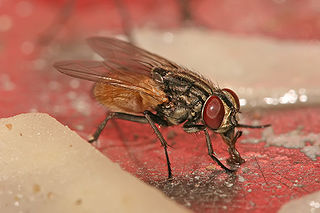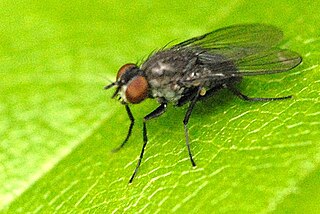
Within the taxonomy of biology, the subfamily Muscinae includes two of the more familiar genera within the Muscidae family; Musca and Stomoxys.

Helina reversio is a fly from the genus Helina, in the family Muscidae. It is a common and variable fly.

Polietes is a genus from the fly family Muscidae.

Coenosiini is a tribe of flies from the family Muscidae.

Graphomya maculata is a species of fly. It is widespread and common in most parts of Europe and also occurs in North Africa including the Canary Islands. The thorax bears the same black and white pattern in both sexes. Females also have a black and white abdomen, while the male has orange colouration on the abdomen as seen in the picture.

Phaonia pallida, the muscid fly or orange muscid fly, is a species of fly in the family Muscidae.

Neomyia cornicina is a common species of fly which is distributed across many parts the Palaearctic. It has been introduced in the Nearctic.

Hydrotaea dentipes is a fly from the family Muscidae. Its larvae have been found in the dung of rabbits, pigs, cows, horses, chickens and humans. It is found in the Palearctic.

Hebecnema umbratica is a fly from the family Muscidae. It is the type species of the genus Hebecnema.

Helina trivittata is a fly from the family Muscidae.
Helina pertusa is a fly from the family Muscidae. It is the type species on the Genus Helina.

Lispocephala is a very large genus of true flies of the family Muscidae.
Lispocephala brachialis is a fly from the family Muscidae.

Villeneuvia is a genus of true flies, belonging to the family Muscidae. There is only one known species. They are very similar to Limnophora, but orbital seta are absent in both sexes.

Hydrotaea diabolus is a fly of the family Muscidae. Its larvae have been found in pig, cow and horse manure. It is found in the Palearctic.

Hydrotaea cyrtoneurina is a fly from the family Muscidae. It is found in the Palearctic.

Lispocephala erythrocera is a fly from the family Muscidae. It is found in the Palearctic.

Phaonia halterata is a fly from the family Muscidae. It is found in the Palearctic.

Phaonia incana is a fly from the family Muscidae. It is found in the Palearctic.

Lispe pygmaea is a fly from the family Muscidae. It is found in the Palearctic.


















